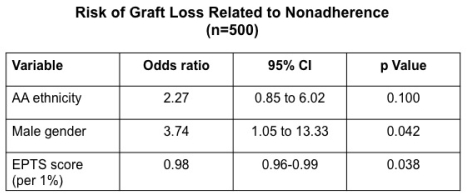Watch Out for the Guy with the Low EPTS Score: Nonadherence and Kidney Allograft Failure.
Medicine, University Hospitals Case Medical School, Cleveland, OH.
Meeting: 2016 American Transplant Congress
Abstract number: A283
Keywords: Age factors, Graft failure, Kidney transplantation
Session Information
Session Name: Poster Session A: Poster Session III: Kidney Complications-Other
Session Type: Poster Session
Date: Saturday, June 11, 2016
Session Time: 5:30pm-7:30pm
 Presentation Time: 5:30pm-7:30pm
Presentation Time: 5:30pm-7:30pm
Location: Halls C&D
Background: Nonadherence is a known cause of rejection and kidney allograft failure. Our aim was to define risk factors for allograft loss related to nonadherence. We surmised from clinical experience that healthier patients with better predicted survival would have a higher rate of graft loss related to nonadherence.
Methods: We analyzed 500 consecutive solitary kidney recipients transplanted between 1/06 and 12/12. The cohort was 52% Caucasian and 43% African American (AA). At the most recent analysis, 81 patients progressed to death-censored allograft failure at a median of 38 mos (range 0-112). Of these, 18 (22%) had failure directly related to documented nonadherence (GLNA). Risk factors for GLNA were analyzed, including the estimated post transplant survival (EPTS) score, which was calculated for all recipients from the time of transplantation.
Results: Patients with GLNA were 83% male, compared to 61% in the remaining cohort (p=0.05). GLNA patients were also 61% AA vs. 42% (p=0.11), and GLNA patients were generally younger with a mean age of 40±15 yrs, compared to 50±13 yrs for the remainder of the cohort (p=0.001). The median EPTS score for GLNA patients was 18% (range 1-81), and half of the GLNA cohort had an EPTS score ≤ 20%. This compared to a median EPTS of 38% (range 1-99) in other patients with allograft loss (p=0.067) and 39% (range 1-99) in the cohort as a whole (p=0.048). Logistic regression for the outcome of GLNA was analyzed for the entire cohort of transplant recipients (Table). Male gender and lower EPTS score remained predictors of GLNA in this model.
Conclusion: We show that male patients deemed to be at the lowest medical risk were the most likely to experience allograft failure related to nonadherence. Such patients were typically healthy, based on EPTS score, and had greater expected survival after transplantation. Methods are needed to target such patients and develop interventions to improve compliance to avoid premature loss of allografts, including low KDPI kidneys which are allocated preferentially to recipients with an EPTS ≤ 20%. Improvements are also critical to avoid unexpectedly poor outcomes within transplant programs.

CITATION INFORMATION: Liu A, Balabhadrapatruni K, Augustine J. Watch Out for the Guy with the Low EPTS Score: Nonadherence and Kidney Allograft Failure. Am J Transplant. 2016;16 (suppl 3).
To cite this abstract in AMA style:
Liu A, Balabhadrapatruni K, Augustine J. Watch Out for the Guy with the Low EPTS Score: Nonadherence and Kidney Allograft Failure. [abstract]. Am J Transplant. 2016; 16 (suppl 3). https://atcmeetingabstracts.com/abstract/watch-out-for-the-guy-with-the-low-epts-score-nonadherence-and-kidney-allograft-failure/. Accessed January 7, 2026.« Back to 2016 American Transplant Congress
